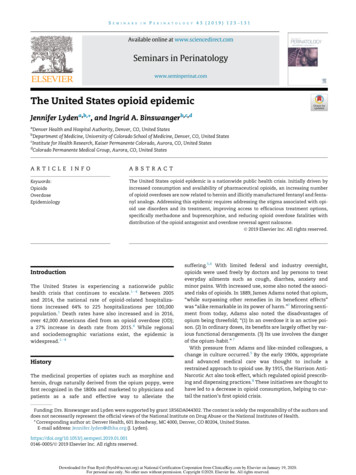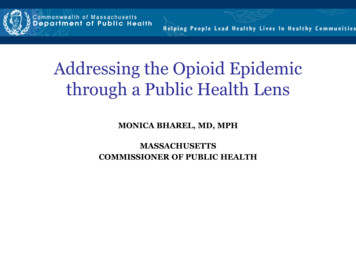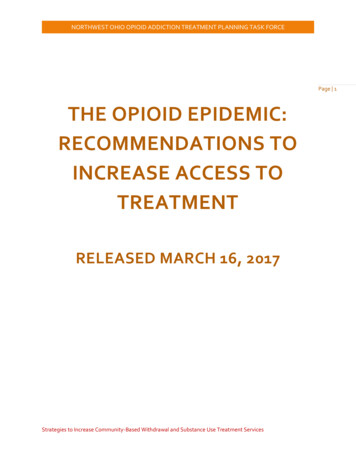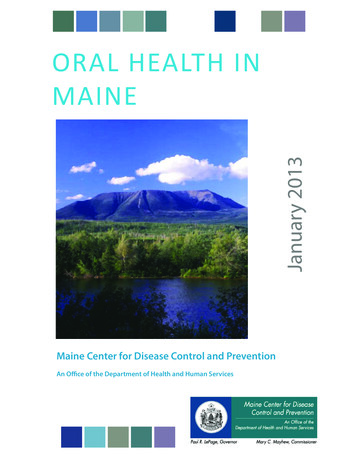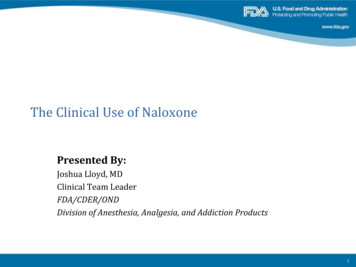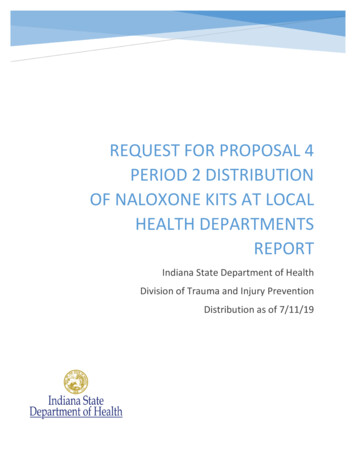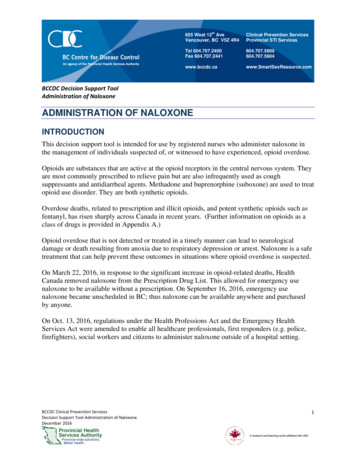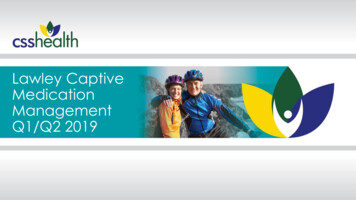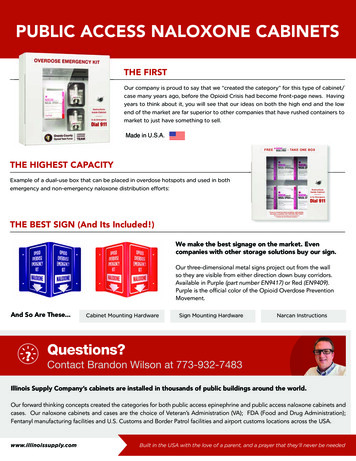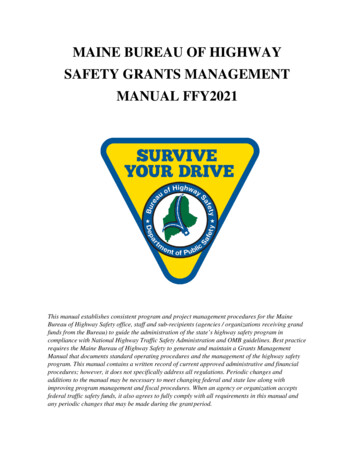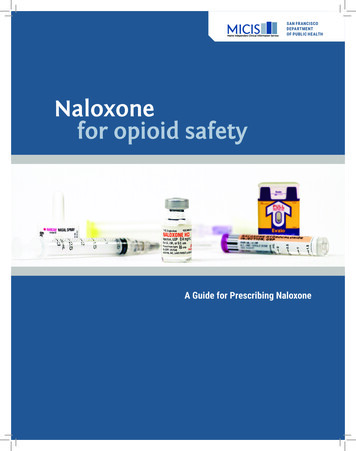
Transcription
SAN FRANCISCODEPARTMENTOF PUBLIC HEALTHNaloxonefor opioid safetyA Guide for Prescribing Naloxone1NALOXONE FOR OPIOID SAFETY
Overdose is the leading causeof injury-related death in the U.S.1100 PEOPLE DIE FROM DRUG OVERDOSE EVERYDAY IN THE UNITED STATESFIGURE 1. MAINE OVERDOSE DEATH BY DRUG TYPE OVER TIME2300250150100500199719981999 2000 2001Total Deaths2002 2003 20042005 20062007 2008 2009 2010Pharmaceutical Opioid Deaths20112012 20132014 2015Illicit Opioid DeathsIn 2015 there were 272 Opioid Overdose deaths in Maine. This is a 31% increasefrom 2014. 111 (41%) of these deaths were due to pharmaceutical opioids.²The majority of opioid overdose deaths (as much as 88%)²involve at least one other drug: Most commonly alcohol,benzodiazepines or cocaine.4Maine Adults between the ages of 30 and 34 had the highestrate of death due to substance abuse or overdose in 2014.4This remained true in 2015, but the mean age was slightlyhigher at 42.²2NALOXONE FOR OPIOID SAFETY
Accidental overdose is preventableThe main risk of death from an opioid overdose is prior overdose.5A patient who has previously overdosed is 6 times more likely tooverdose in the subsequent year.3OTHER FACTORS THAT INCREASE RISK OF OVERDOSE:Reduced Tolerance:Change in DoseUse of Vivitrol Period of Abstinence:Release from prisonRelease from rehabGeneticPredisposition:Male GenderConcomitant Useof Substances:AlcoholBenzodiazepinesCocaineFIGURE 3. OVERDOSE MORTALITY RATE BY WEEK SINCE PRISON RELEASE:Number of deaths per100,000 person yearsAn example of overdose risk if opioids are discontinued and restarted 61,8001,6001,4001,2001,00080060040020001234Weeks since release from prisonWhen a patient reduces or stops opioid use, there is an increasedrisk of overdose death if opioid use increases again.MAINE INDEPENDENT CLINICAL INFORMATION SERVICE SAN FRANCISCO DEPARTMENT OF PUBLIC HEALTH3
Naloxone Highly specific, high-affinity opioid antagonist used to reverse the effects of opioids. Can be safely administered by laypersons via intramuscular or intranasal routes, withvirtually no side effects and no effect in the absence of opioids. Effects last 30-90 minutes; usually sufficient for short-acting opioids but help shouldalways be sought. While high doses of intravenous naloxone by paramedics have been associated with withdrawalsymptoms, lower lay-administered doses produce much more mild symptomatology.7FIGURE 4. NALOXONE MECHANISM OF ACTION 8NaloxoneOpioid receptors on brainNaloxone has a higher affinity to the opioidreceptors than opioids like heroin or oxycodone,so it knocks other opioids off the receptors for30-90 minutes. This reverses the overdose andallows the person to breathe.In 2014, a total of 829 patientsin Maine received naloxoneadministrations from Maine EMSresponders.4Naloxone is effectiveIn California, counties with naloxone programs had anoverall slower rate in the growth in opioid overdose deathcompared to counties without naloxone programs.134NALOXONE FOR OPIOID SAFETY
Naloxone is cost-effective12A manuscript in the Annals of Internal Medicine indicated that providing naloxone to heroinusers is robustly cost-effective and possibly cost-saving. Investigators believe similar resultsapply to other opioid users.Cost:Benefit: 421164 naloxone scripts 1 prevented deathper quality-adjustedlife-year gainedEmerging data suggests that providing naloxone may encourage patients to besafer with their opioid use. If this is the case, the intervention would be cost-savingand 36 prescriptions would prevent one death.Maine Law Encourages Naloxone PrescribingNaloxone is NOT a controlled substance. Any Licensed Healthcare Provider can prescribe naloxone.Maine law provides additional protections to encourage naloxone prescribing and distribution:PRESCRIPTION, POSSESSION, AND ADMINISTRATION (22 M.R.S.A. § 2353(2)) A health care professional may directly or by standing order prescribe naloxone toan opioid user or the user’s family member, friend, etc. In addition, it is now (effective 7/29/16) legal for a pharmacist to dispense and foran individual to possess and administer naloxone without a prescription for usein case of an opioid-related drug overdose. That individual may be the opioid user, a family member, a friend, or any person in a positionto assist an at-risk person. Rules establishing training requirements and dispensing protocols have not yet been established.ADMINISTRATION BY LAW ENFORCEMENT OFFICERS & FIREFIGHTERS (22 M.R.S.A. § 2353(3)) Law enforcement officials and firefighters may administer intranasal naloxone if they havereceived the appropriate trainingCOMMUNITY BASED DRUG OVERDOSE PREVENTION PROGRAMS (22 M.R.S.A. § 2353(4)) Under standing orders from a health care professional, a public health agency may storeand dispense naloxone to anyone who has successfully completed the training program.MAINE INDEPENDENT CLINICAL INFORMATION SERVICE SAN FRANCISCO DEPARTMENT OF PUBLIC HEALTH5
How to PrescriINTRANASALNaloxone HCl Nasal Spray4mg into nostril for suspectedopioid overdose. Call 911.Naloxone 2mg/2ml prefilled syringe,spray ½ into each nostril for suspectedopioid overdose. Call 911. MAD (Mucosal Atomization Device) nasal adapterAtomizer Access is complicated. Pharmacies may needto purchase them directly from a manufacturer.Additional Prescribing information may be foundat prescribetoprevent.org6NALOXONE FOR OPIOID SAFETY
cribe NaloxoneINJECTABLENaloxone 0.4mg/1ml IM for suspected opioid overdose. Call 911.Repeat PRN IM Syringes (3ml 25g 1” syringesare recommended) Dispense Two SyringesAUTO-INJECTORNaloxone Auto Injector 0.4mgDispense one (two pack) Use PRNfor suspected opioid overdose.Call 911.MAINE INDEPENDENT CLINICAL INFORMATION SERVICE SAN FRANCISCO DEPARTMENT OF PUBLIC HEALTH7
Indications for naloxone prescriptionThe American Medical Association has endorsed the distribution of naloxone to anyone atrisk for having or witnessing an opioid overdose.13CONSIDER OFFERING A NALOXONE PRESCRIPTION TO: All patients prescribed long-term opioids Anyone otherwise at risk of experiencing or witnessing an opioid overdoseWHY PRESCRIBE TO ALL PATIENTS ON LONG-TERM OPIOIDS?It is difficult to predict which patients who take prescription opioids are at risk for overdose. any patients do not feel they are at risk for overdose. Prescribing to all patients on opioids willMhelp patients understand naloxone is being prescribed for risky drugs, not risky patients. bout 40% of overdose deaths result from diverted medications.14 Whether intentional orAunintentional, diverted opioids are a serious risk. Co-prescribing naloxone increases the chancethat the antidote will remain with the medication.RISK FACTORS for opioid-induced respiratory depression15:1. Recent emergency medical care for opioid poisoning/intoxication/overdose2. Suspected history of heroin or nonmedical opioid use (e.g., DAST-10)3. High dose opioid prescription (e.g., 100 mg. morphine equivalence/day)4. Any methadone prescription to opioid naïve patient5. Recent release from incarceration/prison/jail6. Recent discharge from opioid detox or abstinence-based program7. In methadone or buprenorphine detox/maintenance for addiction or pain8. Request from patient or family member9. May have difficulty accessing EMS (distance, remoteness, etc.)Any opioid prescription AND 10. Respiratory diagnoses: Smoking/COPD/emphysema/asthma/sleep apnea/ other.11. Renal dysfunction or hepatic disease.12. Known or suspected concurrent alcohol use13. Concurrent benzodiazepine prescription or nonmedical use14. Concurrent SSRI or TCA anti-depressant prescription8NALOXONE FOR OPIOID SAFETY
How to educate patients on naloxoneClinic staff can educate patients aboutWhatnaloxone.isan opioidEducation generally includes:overdose?Common opioidsinclude:GENERICBRAND NAMEHydrocodoneVicodin, Lorcet, Lortab,Norco, ZohydroOxycodonePercocet, OxyContin,Roxicodone, PercodanMorphineMSContin, Kadian,Embeda, AvinzaCodeineTylenol with Codeine,TyCo, Tylenol eOpanaMeperidineDemerolMethadoneDolophine, MethadoseBuprenorphineSuboxone, Subutex,Zubsolv, Bunavail,Butrans When to administer naloxone How to administer naloxone (including demonstration) Informing patients to alert others about the medication,Opioids can cause bad reactions thatmake your breathing slow or even stop.This can happen if your body can’t handlethe opioids that you take that day.TO AVOID AN ACCIDENTALOPIOID OVERDOSE: DO NOT mix your opioids with alcohol,benzodiazepines (Xanax, Ativan,Klonopin, Valium), or medicines thatmake you sleepy.how to use it and where it’s kept, as it is generallynot self-administered Be extra careful if you miss or changedoses, feel ill, or start new medications.Now that you havenaloxone How to UseNaloxone* Heroin is also an Opioid.For patient education, videos andadditional materials, please visitwww.prescribetoprevent.orgBrochures remind patients and caregivers howto manage an overdose. Example brochurescan be found at www.mainemed.com/micis.A GUIDE FOR PATIENTSAND CAREGIVERSTell someone where it is andhow to use it.SAN FRANCISCO DEPARTMENTOF PUBLIC HEALTHSAN FRANCISCO DEPARTMENT OF PUBLIC HEALTHOPIOID SAFETY LANGUAGEThe word “overdose” has negative connotations and prescription opioid usersmay not relate to it.Patients prescribed opioids (including high-risk persons with a history of overdose)reported their risk of “overdose” was 2 out of 10.1712345678910Instead of using the word “overdose,” consider using language like “accidentaloverdose,” “bad reaction” or “opioid safety.” You may also consider saying:“Opioids can sometimes slow or even stop your breathing.”“ Naloxone is the antidote to opioids—to be [sprayed in the nose/injected] if there is a badreaction where you can’t be woken up.”“Naloxone is for opioid medications like an EpiPen is for someone with an allergy.”MAINE INDEPENDENT CLINICAL INFORMATION SERVICE SAN FRANCISCO DEPARTMENT OF PUBLIC HEALTH9
Payment for Educating Patients about NaloxoneSBIRT CODES COVER TRAINING (per 15 min intervals)Training includes: Medicare: G0396 MaineCare: 99408, 99409 if 30mins Commercial: CPT99408 Administering Drug AbuseScreening Test (DAST-10) Counseling on how to:»» recognize overdose»» administer naloxoneInsurance Coverage MaineCare: prefilled syringe & vial (no PA required)Medicare: depends on part D coverage, but some cover all formsVA: vial, auto-injectorCommercial insurers: most do not cover any form, check through individual planThe fact that individuals may purchase naloxone as a bystander (andavailability without prescription) influence the coverage, particularlywith commercial insurers.Cash Prices**Some prices require free online coupons or discount cardsnaloxone 0.4 mg/ml 1 vial (2)naloxone 2 mg/2 ml prefilled syringeNarcan nasal spray (2 pack)Evzio (2 pack) 20- 48 60- 90 140 3,650Source: goodrx.com 10-31-1610NALOXONE FOR OPIOID SAFETY
ResourcesMaine Board of Licensure in Medicine & Maine Board of Osteopathic Licensure: Chapter tmlMaine Office of Substance Abuse: www.maine.gov/dhhs/samhs/osa/helpNorthern New England Society of Addiction Medicine: www.NNESAM.weebly.comPrescribe to Prevent: Clinic-based prescribing information and guidelines: prescribetoprevent.orgReach for Me: Film and resource materials for advocates, families and providers: reach4me.orgMaine Harm Reduction Alliance: ces(1) Warner M, Chen LH, Makuc DM, Anderson RN, Minino AM. Drug poisoning deaths in the United States 1980-2008. National Center forHealth Statistics. 2011;(81):1-8. Updated with Jones, C.M. Prescription Drug Abuse and Overdose in United States. Presented at: Third PartyPayer and PDMP Meeting. 2012. (2) Margaret Chase Smith Policy Center: Drug deaths January-December 2015 statewide brief update (3)Policy Impact: Prescription Painkiller Overdoses. Center for Disease Control and Prevention website. www.cdc.gov/homeandrecreationalsafety/rxbrief/. Updated Jul 2013. Accessed Dec 2014.(4) Substance Abuse Trends In Maine: State Epidemiological Profile 2014, MaineExecutive Summary Section: compiled by Hornby Zeller Associates for Maine Department of Health and Human Services and Office ofSubstance Abuse and Mental Health Services, May 2014 (5) Darke S, Williamson A, Ross J, Teesson M. Non-fatal heroin overdose, treatment exposure and client characteristics: findings from the Australian treatment outcome study (ATOS). Drug Alcohol Rev. 2005;24(5):42532. (6) Binswanger IA, Blatchford PJ, Mueller SR, Stern MF. Mortality after prison release: opioid overdose and other causes of death, riskfactors, and time trends from 1999 to 2009. Ann Intern Med. 2013;159(9):592-600. (7) Enteen L, Bauer J, McLean R, Wheeler E, Huriaux E, KralAH, et al. Overdose prevention and naloxone prescription for opioid users in San Francisco. J Urban Health. 2010;87(6):931-41. (8) Understanding Naloxone. Harm Reduction Coalition website. verview/overdose-basics/understanding-naloxone/. Accessed Dec 2014. (9) Barton ED, Colwell CB, Wolfe T, Fosnocht D, Gravitz C, Bryan T, et al. Efficacy of intranasal naloxone as a needleless alternative for treatment of opioid overdose in the prehospital setting. J. Emerg. Med. 2005;29(3):265-71.(10) Kerr D, Kelly AM, Dietze P, Jolley D, Barger B. Randomized controlled trial comparing the effectiveness and safety of intranasal andintramuscular naloxone for the treatment of suspected heroin overdose. Addiction. 2009;104(12):2067-74. 2014 (11) Davidson PJ, WheelerE, Proudfoot J, Xu R, Wagner K. Naloxone distribution to drug users in California and opioid related overdose death rates. Unpublishedmanuscript; 2014. Dec (12) Coffin PO, Sullivan SD. Cost-effectiveness of distributing naloxone to heroin users for lay overdose reversal. AnnIntern Med. 2013;158(1):1-9. (13) AMA adopts new policies at annual meeting: promoting prevention of fatal opioid overdose. AmericanMedical Association website. dopts-new-policies.page. Jun 2012. Accessed (14)Hirsch A, Proescholdbell SK, Bronson W, Dasgupta N. Prescription histories and dose strengths associated with overdose deaths. Pain Med.2014;15(7):1187-95. (15) Project Lazarus Tool Kit, Community Care of North Carolina, February 2014: loads/pl-toolkit-pcps.pdf (16) Role of Naloxone in Opioid Overdose Fatality Prevention. Food and Drug Administrationwebsite. df. 2012;339-340. Accessed Dec 2014. (17) Patient Interviews. Naloxonefor Opioid Safety Evaluation. San Francisco Department of Public Health. Oct 2013—Dec 2014.Objectives1. Describe recommendations for naloxone prescribing to increase patient safety.2. Understand Maine Law and payment options for naloxone.3. Consider how to implement naloxone prescribing into your practice work flow.4. Prepare scripting for opioid safety discussions with patients, family, or friends.CME Statement: The Maine Medical Education Trust designates this activity for a maximumof 1 AMA PRA Category 1 Credit . Participants should only claim credit commensurate withthe extent of their participation in the activity.The Maine Medical Education Trust is accredited by the Maine Medical Association’sCommittee on Continuing Medical Education and Accreditation to provide ContinuingMedical Education (CME) to physicians.MAINE INDEPENDENT CLINICAL INFORMATION SERVICE SAN FRANCISCO DEPARTMENT OF PUBLIC HEALTH11
About this publicationThis publication was produced by the Maine Independent Clinical Information Service, usingmuch of the content developed by the San Francisco Department of Public Health. Supportwas provided by the National Resource Center for Academic Detailing (NaRCAD). No pharmaceutical company resources were used in the development of these materials, and SanFrancisco authors (Phillip Coffin MD, Assistant Clinical Professor of HIV/AIDS at University ofCalifornia San Francisco, and Emily Behar MS) and Maine author (Erika Pierce MMSc., PA-C)deny any financial conflicts of interest.The recommendations contained in this brochure are general and informational only;specific clinical decisions should be made by providers on an individual case basis.SAN FRANCISCO DEPARTMENT OF PUBLIC HEALTHDesign and layout: Amy Braddock and Lauren A. Mier12Revised November 2016NALOXONE FOR OPIOID SAFETY
4 NALOXONE FOR OPIOID SAFETY Naloxone Highly specific, high-affinity opioid antagonist used to reverse the effects of opioids. Can be safely administered by laypersons via intramuscular or intranasal routes, with virtually no side effects and no effect in the absence of opioids. Effects last 30-90 minutes; usually sufficient for short-acting opioids but help should
